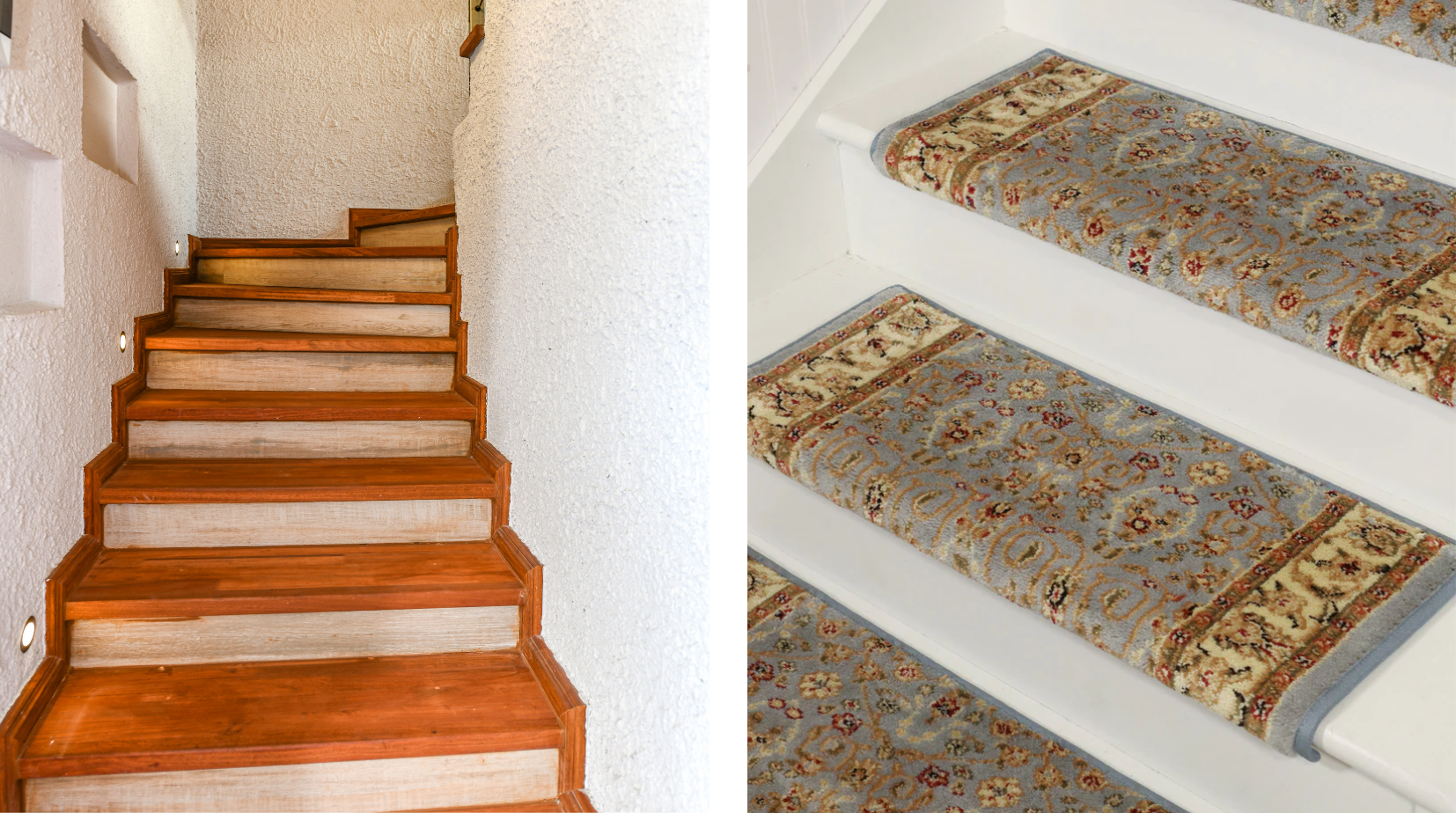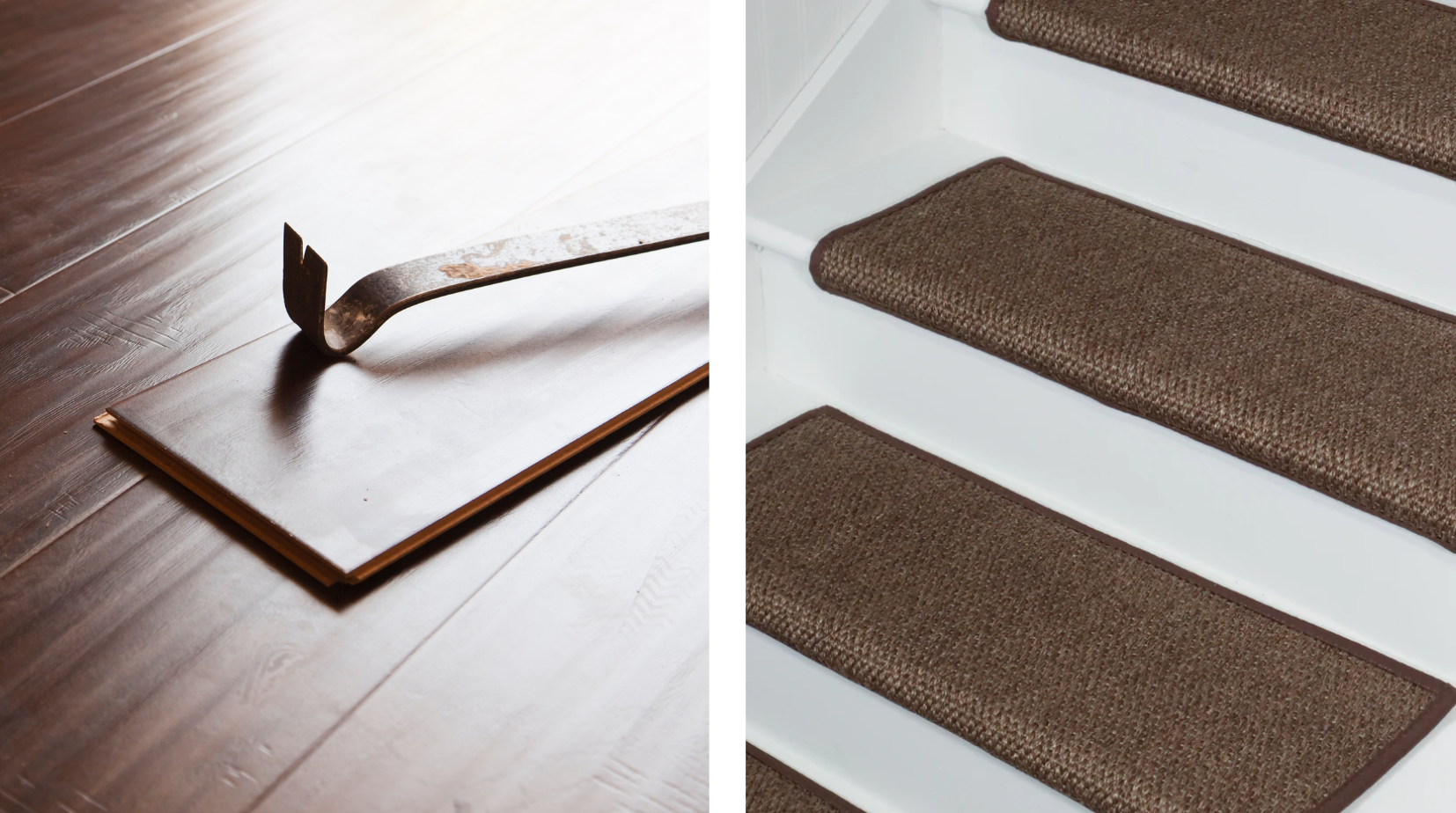Looking to upgrade your stairs but stuck with old, stubborn rubber treads?
The best way for how to remove rubber stair treads is to heat the adhesive with a hairdryer or heat gun, then gently pry up the tread using a putty knife—working slowly to avoid damaging the surface beneath.
Once removed, you’ll be left with a clean foundation that’s ready for a safer, more stylish solution like carpet stair treads.
In this guide, you’ll learn exactly how to remove treads step by step, what tools work best, and how to handle tough adhesives.
We’ll also cover how to prep your stairs for new coverings and avoid common mistakes.
If you’re ready to give your stairs a fresh look with comfort and confidence, you’re in the right place.
What Makes Rubber Treads Tricky To Remove?
Rubber stair treads are often secured with industrial-grade adhesive, which is great for long-term use—but not so great when it’s time to take them off.
If removed incorrectly, rubber treads can leave behind sticky residue, rip up finishes, or even splinter wood steps.
That’s why preparation, patience, and the right tools matter.
Let’s walk through it from start to finish.
Tools and Supplies You’ll Need
Being prepared before you start saves time and frustration.
Essential Tools
-
Pry bar
-
Putty knife or scraper
-
Adhesive remover (citrus-based or solvent-based)
-
Heat gun or hairdryer
-
Clean cloths
-
Mild detergent
Safety Gear
-
Safety goggles
-
Gloves
-
Respirator mask (for fumes)
Step-by-Step: How To Remove Rubber Stair Treads Safely
Ready to get started?
Follow these steps to remove rubber stair treads without damaging your stairs.
Step 1: Prep the Area
Start by clearing the stairwell.
Open windows for ventilation and keep kids or pets out of the area while you work.
Wear your safety gear.
Old adhesive and heat can release strong fumes or particles, especially if you’re scraping.
Step 2: Loosen a Corner of the Tread
Slide your pry bar under one corner of the rubber tread.
Use gentle but firm pressure to lift the edge.
Move slowly along the side, pulling upward as the tread releases.
Try not to yank or rip it off too quickly—this can damage the stair surface underneath.
Step 3: Remove the Full Tread
Once the corner is up, use your hands or the pry bar to carefully peel the entire rubber tread away.
Some treads will lift easily. Others may come off in pieces, especially if they’ve been in place for years.
That’s okay—just take your time.
Step 4: Heat the Adhesive
To loosen any remaining glue, use a heat gun or a standard hairdryer on high heat.
Hold it a few inches away and wave it back and forth.
The heat softens the adhesive so you can scrape it off more easily.
This is a key step if you’re figuring out how to remove stair tread adhesive that’s dried or stubborn.
Step 5: Scrape Carefully
Use a putty knife to scrape the softened adhesive.
Hold the tool flat against the stair to avoid scratching or gouging the surface.
Wipe up debris as you go with a cloth.
What If the Adhesive Is Still Too Strong?
Some adhesives won’t budge with heat alone.
In that case, you’ll need an adhesive remover.
Choosing the Right Adhesive Remover
There are three main types:
-
Citrus-based: Natural, safer for homes with kids or pets. Great for most adhesives.
-
Solvent-based: Stronger, but with harsher fumes. Use with a respirator.
-
Soy-based: Eco-friendly and low-odor, works slower but is effective.
Read the label and always test a small spot before applying to the entire step.
If you’re asking how to remove stair tread adhesive that’s been there for a decade or longer, solvent-based products may be your best bet—but ventilation is key.
Applying It the Right Way
Apply adhesive remover using a cloth or brush (as directed on the product label).
Let it sit for the recommended time.
Then, scrape the adhesive away with a putty knife.
Repeat if needed, and wipe clean with soap and water after you're done.
Removing Carpet Stair Treads: What’s Different?
You may also be wondering how to remove carpet stair treads.
The steps are similar, but there are a few key differences.
Carpet treads are often held in place with double-sided carpet tape or hook-and-loop fasteners (like Velcro), rather than rubber glue.
Carpet Tread Removal Steps
-
Peel up one edge of the carpet tread.
-
If it resists, apply heat or use a putty knife to get under the tape.
-
Remove leftover adhesive tape gently using heat and a scraper.
For Oak Valley Designs carpet treads, the adhesive is low-residue and designed to come off cleanly.
But older models or store-bought versions may leave tape behind that requires more scraping.
How Long Will It Take?
Most homeowners can expect to spend 15–30 minutes per step, depending on how stuck the treads and adhesive are.
If you’re doing 10–12 steps, plan for several hours.
Don’t rush the process—your stairs will thank you later.
Common Mistakes To Avoid
A few small missteps can lead to big problems.
Here’s how to steer clear of them.
Skipping Safety Gear
Adhesive fumes, sharp tools, and slippery residue can be risky.
Always use gloves and goggles—and if fumes are strong, wear a respirator.
Rushing the Removal
Trying to yank up rubber treads in one go can splinter your steps.
Slow and steady wins the race here.
Using the Wrong Tools
Avoid metal scrapers with sharp corners.
A wide, flat putty knife is safer for hardwood and laminate surfaces.
How To Prepare Stairs for New Treads
Once your stairs are clean and dry, you’re ready for what comes next.
If you’re switching to Oak Valley Designs carpet stair treads, your surface should be:
-
Smooth and free of debris
-
Fully dry (moisture can affect the adhesive grip)
-
At room temperature
No need for harsh chemicals or primers.
Our stair treads use a durable, floor-safe adhesive that makes installation easy—and removal just as smooth down the road.
Tips for a Clean Finish
Want your stairs to look flawless after removal?
These simple tips will help you wrap up the job the right way.
-
Wipe each stair with a damp cloth after adhesive removal.
-
Let them air dry for at least an hour.
-
Use painter’s tape to mark where each new tread will go, especially if you're centering carpet treads.
Why It’s Worth Doing Right
This isn’t just a DIY project.
It’s a step toward safer stairs for your kids, your pets—and even for yourself as you grow older.
Upgrading from rubber to carpet treads means better grip, better looks, and less worry.
But doing it right starts with a clean, damage-free removal.
When to Call a Professional
If your stairs are extremely old, painted with lead-based coatings, or coated in layers of glue that just won’t budge, it may be time to call in help.
But for most homeowners, this is a doable weekend project with the right plan.
Frequently Asked Questions
Got questions before you start?
Here are the quick answers you need to move forward with confidence.
Do I have to use a heat gun, or will a hairdryer work?
A hairdryer on high heat works for most adhesives.
A heat gun just speeds things up for tougher spots.
Will adhesive remover ruin wood stairs?
Not if you choose the right type.
Always spot test first and follow product instructions.
Can I install new treads right after cleaning?
Yes, as long as the surface is dry and free of residue.
Moisture or leftover adhesive can affect grip.
Are carpet treads safer than rubber?
Absolutely. Carpet treads offer more grip and comfort—especially if you have kids, pets, or aging knees.
Oak Valley Designs treads are made with family and functionality in mind.
Steps To Success
Removing rubber stair treads doesn’t have to be intimidating.
With a little patience, the right tools, and a touch of DIY confidence, you can transform your stairway in just a few hours.
Whether you're preparing for a full remodel or simply replacing old rubber with something softer underfoot, this process is a meaningful first step.
And when you're ready for that upgrade, Oak Valley Designs is here to help—with easy-to-install carpet stair treads that blend comfort, safety, and Southern-inspired style.
-
Website: https://oakvalleydesigns.com/
-
Phone: 706.331.0315
-
Email: info@oakvalleydesigns.com
-
Address: 30 River Ct SW Bldg E Cartersville, Ga 30120




